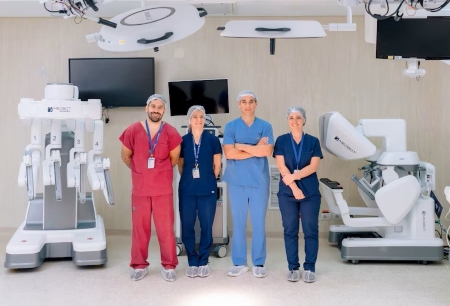Shanghai, China --- on January 14, 2022, Prof. Keqin Hua from the Obstetrics and Gynecology Hospital of Fudan University, Prof. Honghui Zhao from the Fourth Hospital of Harbin Medical University and Prof. Liping Cai of the First Affiliated Hospital of Nanchang University jointly completed the clinical trial on the safety and efficacy of gynecological surgery with Toumai® Laparoscopic Surgical Robot (Toumai®) independently developed by Shanghai MicroPort MedBot (Group) Co., Ltd. (MicroPort® MedBot®). It is the second clinical application field expanded by Toumai® after completing the confirmatory clinical trial of urology surgery. So far, Toumai® has become the first Chinese-developed laparoscopic surgical robot for confirmatory clinical trial case enrollment completed in pelvic cavity.
The Chinese-developed Toumai® robot, as an advanced weapon in the field of gynecological micro-invasive surgery, has fully demonstrated its precision and stability in clinical trials. Its wrist-type surgical instruments are highly flexible, its high-power 3D operation field ensures the accurate exposure of lesions, and its intuitive master-slave teleoperation is sensitive and easy to use, which effectively simplifies the surgery, shortens the operation time, fully possesses the ability to assist doctors in complex operations in the narrow anatomical space of pelvic cavity, and fills the gap of Chinese-developed intellegent manufacturing in this field.
Mr. Yu Liu, Chief Commercial Officer of MicroPort® MedBot®, said, "Thanks to the support of gynecologic clinical experts for the confirmatory clinical trials of Toumai®. Toumai® has successfully completed the extension into gynecologic operation from urology and achieved the clinical application in the whole pelvic cavity. With the promotion of micro-invasive concept, the robotic technologies keep growing day after day in the field of gynecological operation. The value of Chinese-developed Surgical Robots lies in their ability to improve the universality and generality of robot-assisted surgery and thoroughly solve the difficulty for patients to seek surgical treatment, thus to realize the initial goal to ‘Make Surgery Easier, Safer and Less Invasive’”.
-
 2025-12-24Toumai® Becomes the First Chinese Surgical Robot to Achieve the Milestone of 100 Commercial Installations
2025-12-24Toumai® Becomes the First Chinese Surgical Robot to Achieve the Milestone of 100 Commercial Installations -
 2025-12-05Toumai®-Assisted Robotic Ovarian Tissue Autotransplantation Successfully Performed for the First Time in Argentina
2025-12-05Toumai®-Assisted Robotic Ovarian Tissue Autotransplantation Successfully Performed for the First Time in Argentina -
 2025-11-14Toumai® Robotic Fluorescence Imaging System Receives EU CE Certification
2025-11-14Toumai® Robotic Fluorescence Imaging System Receives EU CE Certification






 Hu ICP Bei No. 20013662 HGWA Bei No. 31011502015178
Hu ICP Bei No. 20013662 HGWA Bei No. 31011502015178 " are registered trademarks of Shanghai MicroPort Medical (Group) Co., Ltd.” . They have been authorized to be used by Shanghai Microport Medbot (Group) Co., Ltd., and no other party shall use such trademarks without prior written permission thereof.
" are registered trademarks of Shanghai MicroPort Medical (Group) Co., Ltd.” . They have been authorized to be used by Shanghai Microport Medbot (Group) Co., Ltd., and no other party shall use such trademarks without prior written permission thereof.
